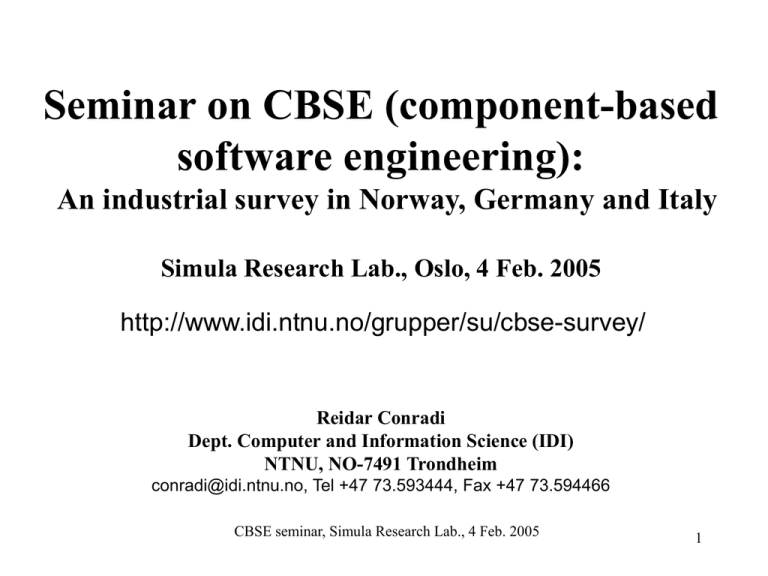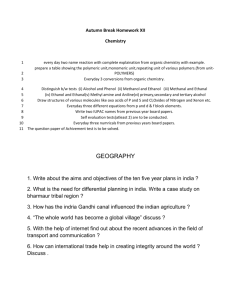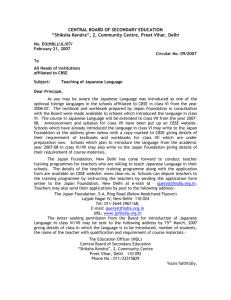Who we are – what we do - Department of Computer and
advertisement

Seminar on CBSE (component-based software engineering): An industrial survey in Norway, Germany and Italy Simula Research Lab., Oslo, 4 Feb. 2005 http://www.idi.ntnu.no/grupper/su/cbse-survey/ Reidar Conradi Dept. Computer and Information Science (IDI) NTNU, NO-7491 Trondheim conradi@idi.ntnu.no, Tel +47 73.593444, Fax +47 73.594466 CBSE seminar, Simula Research Lab., 4 Feb. 2005 1 Agenda for CBSE-seminar 1130-1200 LUNCH and REFRESHMENTS, buffet syle 1200-1215 Reidar Conradi, NTNU: general intro, why is CBSE important? 1215-1230 Christian Bunse, Fraunhofer IESE: CBSE: a short overview. 1230-1245 Maurizio Morisio, Politecnico di Torino: COTS and OSS: what is it? 1245-1300 Preliminary discussion 1300-1400 Jingyue Li et al., NTNU: Main results from survey Section 1: COTS vs. OSS Section 2: Risk management in OTS based development Section 3: Process improvement for OTS based development 1400-1430 Preliminary discussion 1430-1435 Reidar Conradi, NTNU: lottery award ceremony for one respondent 1435-1500 COFFEE BREAK 1500-1530 Additional and more qualitative comments from three companies: - Per Spilling, Objectware - Eivind Tagseth, Abeo (ex-ConsultIT) - Rune Rysstad, WM-data 1530-1545 Odd Petter Slyngstad, NTNU: Method issues in the survey 1545-1615 Final discussion CBSE seminar, Simula Research Lab., 4 Feb. 2005 2 Int’l CBSE survey, 2003-2005 • This is the promised seminar for the survey respondents! • What's in it for you: – – – – learn how to practise CBSE more efficiently identify the major risks and challenges in using CBSE learn from other industrial projects exchange CBSE experiences with industrial colleagues • Target audience: – software professionals and companies that have practiced or want to practice CBSE – researchers that want to learn about issues and results – journalists that want to convey main results back to the ICT community CBSE seminar, Simula Research Lab., 4 Feb. 2005 3 Motivation for CBSE Software reuse: • Any software artifact: rqmts, UML designs, Java code, … • Development ”FOR reuse”: making software parts for later reuse. Investing, need domain insight. • Development ”WITH reuse” (CBSE): composing a software system with pre-made parts. Harvesting. • Component = executable software part, open/closed source: – internal – external: COTS (commercial-Off-The-Shelf) – external: OSS (open source software) 100,000s of external ”OTS”-components, available on web. CBSE seminar, Simula Research Lab., 4 Feb. 2005 4 Component-based system: Application + components + glue/addware CBSE seminar, Simula Research Lab., 4 Feb. 2005 5 Reuse/CBSE – key technology for: • Shorter time-to-market (months) • Increased productivity / lower cost (pays off in 3rd project, in 1st with CBSE) • Better quality (well-tested components) • Promoting standards (domain, architecture, platform) • ... • But may have to adjust the software process CBSE seminar, Simula Research Lab., 4 Feb. 2005 6 Many CBSE challenges: • OTS components used by 30% of Norwegian software projects, 75% are successful. Need guidance. • How to manage risks at different levels – project, requirements, architecture, components, ...? • Process changes: overall planning, increments, requirements management, ”acquire vs. develop”, customer contact, component decisions, … • How to evaluate, integrate and test components? • What is the impact on future maintenance? • How to manage external providers? • … CBSE seminar, Simula Research Lab., 4 Feb. 2005 7 Need empirical base for what works or not • Case studies / post-mortems: – Many reported, also in books [Karlsson95]. – At Ericsson-Grimstad: reused components had less defects, more stable than non-reused ones (Ex.1). – Top 10 COTS issues (Ex.2) [Basili01]. • Controlled experiments: – Hard to apply here, due to lack of realism. • Surveys w/ questionnaires or interviews: – A few studies (Ex.3), including our own. – OSS survey in Italy [Bonaccorsi03]. CBSE seminar, Simula Research Lab., 4 Feb. 2005 8 Ex.1 GPRS/UMTS system at Ericsson-Grimstad Application A Application B Application-specific components Business Specific Middleware (& Component Framework) System Platform Reused components in PhD work [Mohagheghi04] Reused, but considered as COTS and OSS here CBSE seminar, Simula Research Lab., 4 Feb. 2005 9 Ex.2 10 hypotheses on COTS issues [Basili01]. H1: More than 99% of all executing instructions come from COTS components. H2: More than half the features in large COTS components go unused. H3: Average COTS component has new release every 8-9 months. H4: Dev. and post-deployment costs go by (#COTS comp.)**2. H5: Post-deployment costs exceed development costs. H6: Glue-code less than half dev. effort, costing 3x more per LOC. H7: Non-development costs, e.g. licensing fees, are significant. H8: Component assessment and tailoring efforts vary greatly by COTS product classes. H9: Personnel capability and experience are dominant cost factors. H10: COTS-based development is currently high-risk, although many have used it successfully. CBSE seminar, Simula Research Lab., 4 Feb. 2005 10 Ex.3 COTS usage contradicts “common wisdom” Structured interviews of 7 Norwegian and Italian SMEs: Thesis T1: Open-source software is often used as closed source. Thesis T2: Integration problems result primarily from lack of compliance with standards; not architectural mismatches. Thesis T3: Custom code is mainly devoted to add functionalities. Thesis T4: Formal selection seldom used; rather familiarity with product or generic architecture. Thesis T5: Architecture more important than requirements to select components. Thesis T6: Tendency to increase level of control over vendor whenever possible. See [Torchiano04]. CBSE seminar, Simula Research Lab., 4 Feb. 2005 11 Joint CBSE survey in 3 countries • By NTNU/Simula Research Lab, Fraunhofer IESE, and Politecnico di Torino. • Pre-study of 16 projects in Norway in 2003. • Questionnaire in native language + English, using SESE web tool at Simula. • Asking 800-900 companies in 3 countries, aim for 150 reponses (40% of 30%?). • Have ca. 80 responses, 50 from Norway. • Main study: May 2004 - March 2005. CBSE seminar, Simula Research Lab., 4 Feb. 2005 12 Main results • 30% of the IT companies had applied CBSE. • 3/4 of projects in these had success with CBSE. • Most projects searched the Internet for components, then tried out a few, before making a decision. • An incremental process is advisable to allow (re)negotiation of requirements. • Component quality is not always a major concern. • Local expert on the actual components is a big asset. CBSE seminar, Simula Research Lab., 4 Feb. 2005 13 Other results • OSS components (open source) might be preferred, as they allow local changes. • COTS providers gave better technial support than OSS ones. • COTS components generally followed market trends. • Underestimation of integration and maintenance effort was a problem. CBSE seminar, Simula Research Lab., 4 Feb. 2005 14 Conclusion • First representative, int’l CBSE survey • Many interesting results, some surprising (webbased evaluation process) • Later supplement by qualitative interviews and real case studies, also look at WebServices • Re-do survey in UK and USA? • Surveys (as any other studies) are hard work! CBSE seminar, Simula Research Lab., 4 Feb. 2005 15 Literature list (1) • • • • • • • • • [Basili01] Victor R. Basili and Barry Boehm, “COTS-Based Systems Top 10 List”, IEEE Computer, 34(5):91-93, May/June 2001. [Boehm99] Barry W. Boehm and Chris Abts, “COTS integration: Plug and Pray?”, IEEE Computer, 32(1):135-138, Jan. 1999. [Boehm03b] Donald J. Reifer, Victor R. Basili, Barry W. Boehm, and Betsy Clark, “Eight Lessons Learned in COTS-based Systems Maintenance”, IEEE Software, 20(5):94-96, Sept./Oct. 2003. [Bonaccorsi03] Andrea Bonaccorsi and Cristina Rossi, "Why Open Source software may succeed”, Research Policy, 32(7):1243–1258, 2003. [COCOTS00] Chris Abts, Barry W. Boehm, and Elizabeth Bailey Clark, “COCOTS: A COTS Software Integration Lifecycle Cost Model- Model Overview and Preliminary Data Collection Findings”. Technical report: USC-CSE-2000-501, http://sunset.usc.edu/publications/TECHRPTS/2000/usccse2000-501/usccse2000-501.pdf. [Comella-Dorda02] Santiago Comella-Dorda, John C. Dean, Edwin Morris, and Patricia Oberndorf, “A Process for COTS Software Product Evaluation”, First Int’l Conference on COTSBased Software Systems (ICCBSS’02), Orlando, FL, USA, February 4-6, 2002, Springer Verlag LNCS 2255, ISBN 3-540-43100-4, pp. 176-187. [Heineman00] George T. Heineman, William T. Councill, Janet S. Flynt, Alok Mehta, John R. Speed, and Mary Shaw, “Component-based software engineering and the issue of trust”, 22nd Int’l Conference on Software Engineering (ICSE’2000), Limerick, Ireland, IEEE-CS Press, 4-11 June 2000, pp. 661-664. [Frakes95] William B. Frakes and Christopher J. Fox, “Sixteen Questions About Software Reuse”, CACM, 38(6):75-87, June 1995. [Karlsson95] Even-André Karlsson (Ed.), "Software Reuse: A Holistic Approach" (The REBOOT Methodology Handbook), Wiley Series in Software Based Systems. John Wiley. 510 p., 1995. ISBN 0-471-95819-0. CBSE seminar, Simula Research Lab., 4 Feb. 2005 16 Literature list (2) • • • • • • • • [Li04] Jingyue Li, Finn Olav Bjørnson, Reidar Conradi, and Vigdis By Kampenes, "An Empirical Study of Variations in COTS-based Software Development Processes in Norwegian IT Industry", 10th IEEE International Metrics Symposium (Metrics'04), Sept. 14-16, 2004, Chicago, p. 72-83. Recommended for journal publication in Empirical Software Engineering. This contains results from the pre-study in Norway in 2003. [Li05] Jingyue Li, Reidar Conradi, Odd Petter N. Slyngstad, Christian Bunse, Marco Torchiano, and Maurizio Morisio, "Preliminary Results of a State-of-the-Practice Survey on Motivations of Using Off-The-Shelf Components", Submitted to 6th International Conference on Product Focused Software Process Improvement (PROFES'2005), 13-16 June, 2005, Oulu, Finland, 17 p. This serves as the technical report of the main study in 2004, the OTS survey. [Mohagheghi04] Parastoo Mohagheghi, Reidar Conradi, Ole M. Killi, and Henrik Schwarz, "An Empirical Study of Software Reuse vs. Defect Density and Stability", 26th Int’l Conference on Software Engineering (ICSE'2004), 23-28 May 2004, Edinburgh, Scotland, IEEE-CS Press, pp. 282-292 (given one of the five Distinguished Paper Awards at ICSE’04). [Morisio00] Maurizio Morisio, Carolyn B. Seaman, Amy T. Parra, Victor R. Basili, Steve E. Kraft, and Steven E. Condon, “Investigating and Improving a COTS-Based Software Development Process”, 22nd Int’l Conference on Software Engineering (ICSE’2000), Limerick, Ireland, IEEE-CS Press, 4-11 June 2000, pp. 31-40. [Morisio02] Maurizio Morisio, Michel Ezran, and Colin Tully, “Success and Failure Factors in Software Reuse”, IEEE Trans. on Software Engineering, 28(4):340-357, April 2002. [Ropponen00] Janne Ropponen and Kalle Lyytinen, “Components of Software Development Risk: How to Address”, IEEE Trans. on Software Engineering, 26(2):98-111, Feb. 2000. [Szyperski03] Clemens A. Szyperski, “Component Technology - What, Where, and How?”, 25th Int’l Conference on Software Engineering (ICSE’2003), Portland, Oregon, USA, IEEE-CS Press, 3-10 May 2003, pp. 684-693. [Torchiano04] Marco Torchiano and Maurizio Morisio, "Overlooked Facts on COTS-based Development", IEEE Software, 21(2):88-93, March/April, 2004. CBSE seminar, Simula Research Lab., 4 Feb. 2005 17


